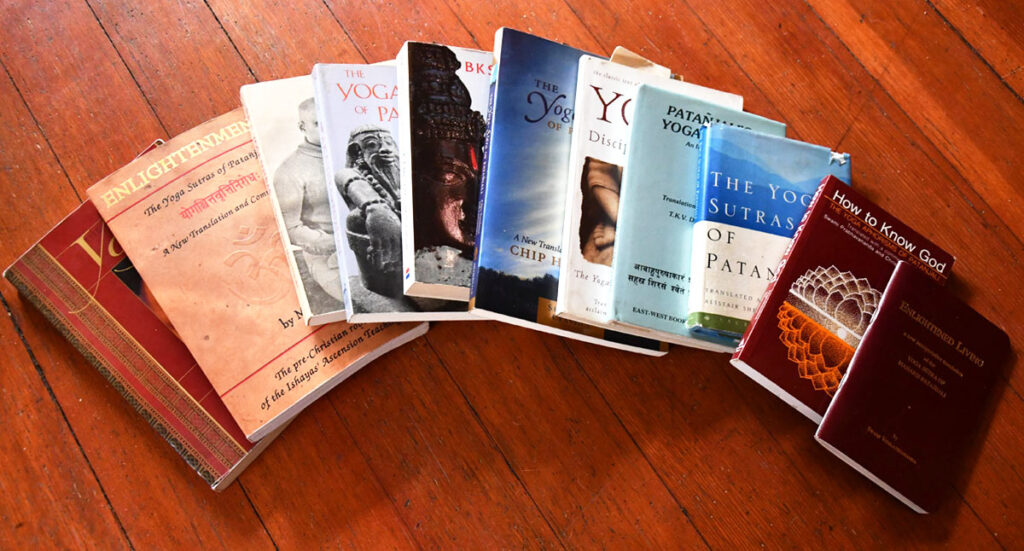This entry was posted on Dec 6, 2022 by Charlotte Bell.

What’s yoga? In one other article, I tried to summarize the totally different facets of yoga. However I said the caveat that yoga will not be really easy to outline. As a 5,000-year-old apply, there are a complete lot of opinions about what yoga is, which tells me that defining yoga is each private and common. That’s what makes it such a dynamic apply. Many historical texts try to outline yoga. Within the West, one of the best identified of those embrace: the Upanishads, The Bhagavad Gita and the Yoga Sutras of Patanjali. Most Western yoga practitioners look to the Yoga Sutras to reply the what’s yoga query.
What Are the Yoga Sutras?
The Yoga Sutras are a compilation of concepts about yoga that had fashioned over centuries. They had been possible compiled someplace between 500 BCE and 400 CE. Nobody is aware of something concerning the purported writer, Patanjali, besides that he’s typically referred to as a sage.
The phrase sutra means “thread.” Every of the 196 sutras—that are brief aphorisms—is a thread within the bigger tapestry of yoga. The textual content consists of 4 elements. I’ll use Alistair Shearer’s translation of the sutra sections right here, just because it was the core textual content of my sutra research:
- The Settled Thoughts: An summary of what yoga is
- Treading the Path: The “how-to” a part of the textual content
- Growth: An outline of the powers of a concentrated thoughts
- Enlightenment: Qualities of awakening
How Do the Yoga Sutras Outline Yoga?
Sutra 1.2 (the second aphorism within the textual content) gives the definition of yoga. All the remainder of the sutras flesh out this definition. Listed below are a couple of translations:
These are simply 5 of the dozen sutra translations I used when my research companion and I spent seven years exploring the sutras. (That is to say that this brief article solely barely factors to the sutras’ definition of yoga!)
As you may see, there are many totally different interpretations. It’s because the sutras had been written with none form of non secular coloration. Due to this, every translation displays the translator’s interpretation. That’s why it’s essential to check greater than only one translation. In my research, I additionally learn translations by Georg Feuerstein, B.Ok.S. Iyengar and Chip Hartranft, to call a couple of.
The Settling of the Thoughts
My favourite general translation is Alistair Shearer’s, together with and particularly his translation of sutra 1.2. Whereas Shearer’s translation of the sutras will not be as literal as some, I really feel that it expresses the essence of the sutras.
“Yoga is the settling of the thoughts into silence” speaks to a technique of gradual awakening. The phrase “settling” is dynamic somewhat than static. I see the trail of yoga as an ongoing course of, all the time altering and evolving, and settling into what’s true. It’s not a static aim that you simply sometime attain after which all the things stops. It’s a gradual, however dynamic, course of.
What’s the silence this sutra factors to? It’s a silence that’s not depending on an absence of enter from our senses. It’s a huge, limitless consciousness that’s undisturbed by seeing, listening to, tasting, smelling, feeling and pondering. A typical metaphor for the silence of yoga is the sky. Whereas every kind of climate occasions—wind, rain, snow, tropical storms, tornadoes, and so forth.—could happen throughout the context of the sky, the sky by no means loses its integrity, its sky-like nature.
Learning the Sutras
I encourage you to delve into the sutras. My research companion and I every used a couple of dozen translations. Alistair Shearer’s translation was our baseline, and we used the others, together with the commentaries, to assist us flesh out our understanding. The sutras are divided into small segments of three to 5 aphorisms. We spent a month learning one in all these sections on our personal, after which met to debate what we’d found. It took us about seven years, and by the tip of it, we agreed that we may simply begin over once more!
About Charlotte Bell
Charlotte Bell found yoga in 1982 and commenced educating in 1986. Charlotte is the writer of Conscious Yoga, Conscious Life: A Information for On a regular basis Apply and Yoga for Meditators, each printed by Rodmell Press. Her third e book is titled Hip-Wholesome Asana: The Yoga Practitioner’s Information to Defending the Hips and Avoiding SI Joint Ache (Shambhala Publications). She writes a month-to-month column for CATALYST Journal and serves as editor for Yoga U On-line. Charlotte is a founding board member for GreenTREE Yoga, a non-profit that brings yoga to underserved populations. A lifelong musician, Charlotte performs oboe and English horn within the Salt Lake Symphony and folks sextet Purple Rock Rondo, whose DVD gained two Emmy awards in 2010.

